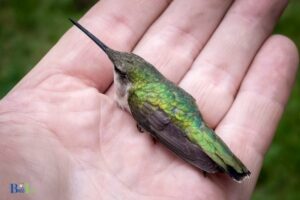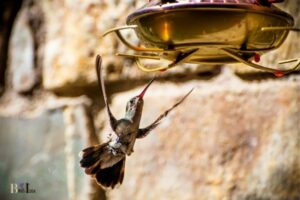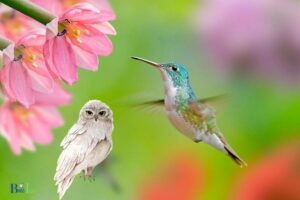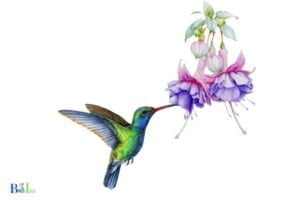How to Get a Hummingbird to Land on Your Hand? 10 Steps!
To get a hummingbird to land on your hand, you need to establish trust, remain patient, and create a comfortable environment for the bird.
Hummingbirds are small, fast, and cautious creatures. Gaining their trust is the key to getting them to land on your hand.
It might take some time, but with patience and consistency, you can successfully make a hummingbird feel comfortable enough to perch on your fingers.
Create a hummingbird-friendly environment by setting up a feeder with fresh nectar, ensuring they have a safe and consistent food source.
Establish a routine with your feeder by refilling it at the same time every day so the birds become accustomed to your presence.
Practice patience and stillness as you wait for the hummingbirds to approach your hand; avoid sudden movements as they might scare the birds away.
Finally, wear colors that attract hummingbirds like bright reds or other vibrant hues, making you more visible and inviting to these curious creatures.
10 Steps to Get a Hummingbird to Land
| Step | Description |
|---|---|
| 1 | Choose a suitable location: Find an area with flowers or a hummingbird feeder where hummingbirds frequent. |
| 2 | Observe their patterns: Spend some time watching the hummingbirds’ behavior and take note of their feeding habits and schedule. |
| 3 | Wear inconspicuous clothing: Dress in clothes that blend in with the environment to avoid scaring them away. Avoid bright colors and shiny objects. |
| 4 | Remain still and patient: Stand or sit still close to the feeder or flowers, and avoid making sudden movements. Hummingbirds are skittish and may take some time to become accustomed to your presence. |
| 5 | Remove other perching options: Temporarily remove nearby branches or other possible perches to encourage the hummingbird to land on your hand. |
| 6 | Hand placement: Slowly extend your arm and place your hand near the feeder or flowers with your fingers together and your palm facing upward. |
| 7 | Offer food: Place a small container or bottle cap filled with sugar water (4 parts water, 1 part sugar) in the center of your palm. |
| 8 | Repeat visits: If a hummingbird does not land on your hand initially, try again at different times or days. Consistency and patience are key. |
| 9 | Stay relaxed: As the hummingbird approaches, remain calm and steady. Quick movements will scare them away. |
| 10 | Enjoy the experience: Once the hummingbird lands on your hand, cherish the moment and remember to stay still until it decides to fly away. |
Key Takeaway

Five Facts About Getting Hummingbird to Land
How A Hummingbird Sees
Understanding A Hummingbird’S Perspective
Hummingbirds are tiny and agile birds that move at incredibly high speeds. To attract a hummingbird to land on your hand, you must first understand how they see and perceive their surroundings.
- A hummingbird’s eyes are located on either side of its head, giving it a 360-degree view of the area around it.
- They have excellent color vision due to the high number of light-sensitive cones in their eyes.
- Hummingbirds can see ultraviolet light, which enables them to recognize hidden patterns on flowers, making it easy for them to find nectar.
Recognizing The Importance Of Color
Hummingbirds have a strong preference for certain colors, making it easier to attract them by planting flowers or wearing the right colors.
- Red is perhaps the most popular color among hummingbirds, followed by orange and pink.
- They are attracted to bright and vibrant colors such as red, orange, and pink, as they are the colors that resemble the nectar of flowers.
- Hummingbirds are also attracted to shades of blue and purple, although not as strongly as they are to other colors.
Using Color And Pattern To Attract Hummingbirds
To get a hummingbird to land on your hand, you must create a space that is suitable for them and attracts them with the right colors and patterns.
Here’s how you can make it happen:
- Wear something red, pink, or orange to attract hummingbirds to come close.
- Create a suitable environment by planting flowers with the colors and patterns that hummingbirds like.
- You can also place a hummingbird feeder on your hand to get them to land on you.
- Use a brightly colored dish to place food instead of using a hummingbird feeder, as it is an excellent way to get them closer to your hand.
- Remember to sit still and remain patient as hummingbirds are cautious creatures and may take some time to approach you.
Once you have successfully attracted a hummingbird to your hand, remember to remain calm and still to avoid scaring them away.
Offering nutrient-rich food, such as nectar or sugar water, will also encourage them to stay longer, allowing you to observe these beautiful creatures up close.
Creating A Safe Environment
Creating A Safe Environment For Hummingbirds
Hummingbirds are delicate creatures, and it’s crucial to create a safe environment if you want them to land on your hand.
Here are some essential tips to help you transform your backyard or garden into a hummingbird haven.
Providing The Right Types Of Food
Hummingbirds are attracted to bright colors and sugary nectar. It’s essential to provide them with the right types of food to keep them coming back.
Here are some tips on what kind of food to offer them:
- Use a mixture of four parts water and one part white granulated sugar to make nectar. Avoid using honey, red dye, or artificial sweeteners.
- Change the nectar every 2-3 days, especially during hot weather. Discard any leftover nectar before refilling the feeder.
- If you have a garden, plant nectar-rich flowering plants such as bee balm, salvia, or cardinal flower. These will supplement their diet and provide them with natural sources of food.
- Avoid feeding them food that is high in protein, such as peanut butter and fruit. This can lead to severe health problems and is not suitable for birds.
Choosing The Ideal Location For Your Feeder
The location of your feeder is just as crucial as the type of food you offer.
Here are some tips on choosing the best location for your hummingbird feeder:
- Hang the feeder in a shaded area to prevent the nectar from spoiling quickly. Direct sunlight can cause the nectar to ferment and grow mold.
- Place the feeder in an area that is sheltered from strong winds, and avoid placing it near windows or reflective surfaces. This can confuse the birds and cause them to collide with your windows, leading to severe injuries or death.
- Hang the feeder at a height of four to five feet above the ground, and ensure that it’s easily accessible for refilling and cleaning.
Maintaining A Clean Environment
Maintaining a clean environment is essential for the health and safety of the hummingbirds.
Here are some tips on how to maintain a clean area:
- Clean the feeder thoroughly every time you refill it. Use hot water and vinegar to remove any bacteria or mold that may have developed.
- Use a bottle brush or pipe cleaner to clean the feeder’s nooks and crannies to ensure that there are no leftover nectar residues.
- Discard any leftover nectar from the feeder after three days, and clean it thoroughly before refilling.
- Clean the area around the feeder frequently to remove any fallen nectar that can attract insects or ants.
Providing hummingbirds with a safe environment is a critical step to attract them to your garden or backyard. Following these tips will ensure that your feeder is a welcoming space for these beautiful creatures.
Building Trust
Hummingbirds are beautiful creatures that are admired by many. They are fascinating to observe and if you’re lucky, you might even have one land on your hand someday.
However, attracting a hummingbird to your hand can take patience, time, and effort. In this blog post, we will discuss the importance of building trust with hummingbirds and how you can achieve it.
Starting With A Feeder
If you’re new to attracting hummingbirds, it’s important to start with a feeder. Hummingbirds are highly attracted to the color red, so make sure to choose a feeder that is predominantly red.
Hang the feeder somewhere visible, yet safe for the birds. Once you have regular hummingbird visitors to your feeder, it’s time to move on to the next step.
Gradually Moving Your Hand Closer
Now that you have regular hummingbird visitors to your feeder, it’s time to start building trust. Begin by standing or sitting near the feeder and holding your hand out next to it, making sure your hand is completely still.
After a while, move your hand closer to the feeder, slowly increasing the distance each time the hummingbirds feed.
Eventually, the hummingbirds will become more comfortable with your hand being close to their feeder.
Offering A Resting Place
Once the hummingbirds are comfortable with your hand being close to their feeder, it’s time to offer them a resting place.
You can do this by simply holding out a branch or small twig for them to perch on. Keep in mind that hummingbirds are easily scared, so it’s important to be still and gentle.
Eventually, the hummingbirds will learn to trust your outstretched hand as a safe place to land. Building trust with hummingbirds takes time, patience, and effort.
By starting with a feeder, gradually moving your hand closer, and offering a resting place, you can eventually gain their trust and have a hummingbird land on your hand. Remember to always be gentle, still, and respectful of these beautiful creatures.
Successfully Landing A Hummingbird On Your Hand
Hummingbirds are incredible creatures that captivate the attention of bird watchers and nature lovers alike. If you’re interested in getting a hummingbird to land on your hand, there are a few key things to keep in mind.
Patience Is Key
Hummingbirds can be skittish creatures, so it’s important to approach them with patience. Keep in mind that it may take some time before a hummingbird feels comfortable enough to land on your hand.
Here are a few tips to help you cultivate patience when trying to attract hummingbirds to your hand:
- Find a comfortable spot to sit and observe the hummingbirds in their natural habitat
- Take deep, calming breaths to help relax your body and mind
- Remember that each hummingbird has its own unique personality and may require a different approach
Avoid Sudden Movements Or Loud Noises
Hummingbirds are easily startled, so it’s important to avoid sudden movements or loud noises when attempting to get them to land on your hand.
Here are a few tips to help you minimize sudden movements or loud noises:
- If possible, wear clothing that is a similar color to the hummingbirds’ environment
- Move slowly and deliberately, avoiding sudden jerky movements
- Try to be as quiet as possible, avoiding talking or other loud noises
Provide A Stable And Comfortable Platform
Hummingbirds require a stable and comfortable platform in order to feel safe enough to land on your hand.
Here are a few tips to help you provide a stable and comfortable platform:
- Hold your hand out flat, with your fingers and thumb close together
- Keep your hand steady, avoiding any sudden movements or wobbling
- Use a small dish of sugar water or nectar to attract the hummingbirds to your hand
Remember that successfully landing a hummingbird on your hand requires patience, a calm demeanor, and a stable platform. With a little practice and perseverance, you can create a magical moment that will stay with you for a lifetime.
FAQ About Attracting Hummingbird
How Do I Attract Hummingbirds To My Hand?
What Time Of Day Is Best To Attract Hummingbirds?
How Do I Stay Still Enough For Hummingbirds To Land On My Hand?
Why Won’t Hummingbirds Come To My Hand?
Is It Safe To Have Hummingbirds Land On My Hand?
Conclusion
As you may now realize, getting a hummingbird to land on your hand is an achievable and rewarding experience. By following the guidelines outlined in this post, such as maintaining stillness, providing a source of food and water, and creating a trust-based relationship, you can increase your chances of attracting these tiny birds.
It takes patience and persistence, but the moment a hummingbird finally lands on your hand is one you will never forget. Remember to always approach with kindness and care, and never force or harm these beautiful creatures.
Whether you are a nature enthusiast or simply seeking a unique form of entertainment, the experience of having a hummingbird on your hand is truly unforgettable. With these tips and a bit of luck, you’ll be inviting these winged visitors to land on your hand in no time.






